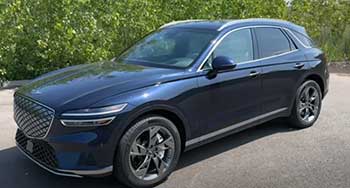
I’ve always been drawn to luxury SUVs that blend style, performance, and innovation, so when I set out to compare the Range Rover Velar and the Genesis GV70 Electric, I knew I was in for an exciting ride.
My goal was to explore these two vehicles from a driver’s perspective, weighing their strengths and weaknesses to help you decide which one fits your lifestyle.
With the Velar’s plug-in hybrid power and the GV70 Electric’s all-electric promise, this comparison is about finding the perfect balance of luxury, efficiency, and practicality for you.
Comparison Table
| Feature | Range Rover Velar P400e | Genesis GV70 Electric |
|---|---|---|
| Powertrain | Plug-in Hybrid (2.0L Turbo + Electric Motor, 297kW, 640Nm) | All-Electric (Dual Motors, 360kW, 700Nm) |
| Price (MSRP) | $62,875 – $89,950 | $68,400 – $75,000 |
| Electric Range | 50km (real-world) | 454km (EPA estimated) |
| Fuel Economy | 22 MPG city / 26 MPG highway (gas), 1150km total range | 98 MPGe city / 83 MPGe highway |
| Cargo Space | 30.9 ft³ (seats up), 56.5 ft³ (seats folded) | 28.7 ft³ (seats up), 56.5 ft³ (seats folded) |
| Horsepower | 396 hp (P400) | 483 hp |
| 0-60 mph | 5.2 seconds | 4.5 seconds |
| Interior Features | 11.4-inch Pivi Pro infotainment, optional knit fabric upholstery | 14.5-inch touchscreen, Smart Parking Assist, 115-volt outlet |
| Safety Rating | Not rated by IIHS (2024) | IIHS Top Safety Pick Plus (2022) |
| Warranty | 48 months / 80,000 km | 60 months / 100,000 km |
My Experience With Range Rover Velar
Stepping into the Range Rover Velar P400e felt like entering a sleek, modern art gallery on wheels. Its exterior design is a head-turner—those slender LED headlights and flush door handles give it a futuristic edge that screams sophistication.
I drove the Dynamic HSE trim, which blends a 2.0-liter turbocharged engine with an electric motor for a combined 297kW and 640Nm of torque. The moment I pressed the accelerator, the Velar surged forward with a refined growl, hitting 0-60 mph in about 5.2 seconds. It’s not a sports car, but it’s punchy enough for city merges and highway passes.
The interior is where the Velar truly shines. The 11.4-inch Pivi Pro infotainment screen floats elegantly, controlling everything from navigation to climate settings. I loved the minimalist cabin, though I noticed the absence of physical buttons made me rely heavily on the touchscreen, which wasn’t always intuitive.
The seats were plush, with excellent lumbar support, perfect for long drives. However, I found myself wishing for standard heated seats or a head-up display, especially at this price point—$143,508 for the P400e HSE Dynamic before on-road costs.
On the road, the Velar’s ride was smooth but firmer than expected, especially on standard steel springs. I took it on a weekend trip, and its 214mm ground clearance handled light off-road trails with ease, a nod to its Range Rover heritage. The plug-in hybrid system offered about 50km of real-world electric range, which was great for short commutes, but I had to plug it in regularly to maximize efficiency.
Charging on a 7.0kW system took just over two hours, which was convenient, but I couldn’t help feeling the Velar’s fuel economy (22 MPG city, 26 MPG highway) lagged behind competitors when not in electric mode.
Overall, driving the Velar was a luxurious experience, but it came with trade-offs. Its style and off-road capability are unmatched, yet the lack of standard features and occasional tech quirks left me wanting more for the price.
My Experience With Genesis GV70 Electric
The Genesis GV70 Electric was a different beast altogether. From the moment I slid into the driver’s seat, I was struck by its opulent interior—think Bentley vibes on a budget. The 14.5-inch touchscreen dominates the dashboard, paired with a rotary controller that’s both tactile and intuitive, though I kept mistaking it for the gear selector.
With dual electric motors delivering 360kW and a whopping 700Nm of torque, this SUV felt like a rocket, sprinting from 0-60 mph in just 4.5 seconds. The “Boost” button on the steering wheel unleashed all 490hp for a thrilling 10-second surge—perfect for overtaking on highways.
The GV70 Electric’s cabin is a standout, with high-quality leather and a layout that feels both luxurious and functional. I appreciated the 115-volt outlet for charging my laptop and the Smart Parking Assist, which effortlessly backed the car into tight spots.
The ride was remarkably quiet, even at motorway speeds, thanks to its all-electric powertrain and refined suspension. I tested it on a 300-mile road trip, and its 454km EPA-estimated range held up well, though cold weather dipped it closer to 400km.
However, the GV70 Electric isn’t perfect. Its cargo space (28.7 ft³ with seats up) felt slightly cramped compared to the Velar, and rear legroom was a tad tight for taller passengers.
The lack of a frunk was a missed opportunity for extra storage. Still, the GV70’s efficiency (98 MPGe city, 83 MPGe highway) and lower starting price of $68,400 made it feel like a better value than the Velar. Plus, its IIHS Top Safety Pick Plus rating gave me peace of mind.
Driving the GV70 Electric was a joy—fast, quiet, and packed with tech. It’s a compelling choice for anyone prioritizing efficiency and modern features over traditional luxury branding.
Read more: My Thoughts on GMC Terrain Vs. Ford Escape
Pros Of Range Rover Velar

- Stunning Design: The Velar’s sleek lines, flush door handles, and pixel LED headlights make it one of the most stylish SUVs on the road, turning heads wherever I drove.
- Off-Road Capability: With 214mm of ground clearance and Range Rover’s Terrain Response system, it handled light off-road trails with confidence, perfect for weekend adventures.
- Powerful Plug-In Hybrid: The P400e’s 297kW and 640Nm deliver smooth, responsive acceleration, blending electric efficiency with gas-powered range for versatility.
- Luxurious Interior: The minimalist cabin, with its 11.4-inch Pivi Pro screen and plush seats, feels like a high-end lounge, ideal for long drives.
- Smooth Ride: Despite a firmer suspension, the Velar glides over most road imperfections, making it a comfortable cruiser for city and highway driving.
The Velar’s design is its biggest selling point. I felt like I was driving a piece of art, with its sculpted body and modern aesthetic standing out in a sea of generic SUVs. The off-road capability, while not as robust as larger Range Rovers, gave me confidence on gravel paths and muddy trails during a weekend getaway.
The plug-in hybrid system was a pleasant surprise, offering enough electric range for daily commutes while the 69L fuel tank extended my theoretical range to 1150km.
The interior’s minimalist approach, with high-quality materials like optional knit fabric upholstery, added a unique touch, though I missed some premium features like heated seats. Overall, the Velar balances style, performance, and mild off-road prowess, making it a strong contender in the luxury SUV market.
Cons Of Range Rover Velar
- Expensive Options: Many luxury features, like heated seats or a head-up display, are costly add-ons, which feels stingy at a $143,508 price point for the P400e.
- Limited Electric Range: The 50km real-world electric range is decent but falls short for longer trips, requiring frequent charging to maximize efficiency.
- Subpar Fuel Economy: At 22 MPG city and 26 MPG highway, the Velar’s gas mode efficiency lags behind competitors like the Volvo XC60.
- Tech Quirks: The Pivi Pro infotainment system, while sleek, can be laggy and overly reliant on touchscreen inputs, which distracted me while driving.
- Uninspiring Steering: The steering feels overboosted and lifeless, requiring constant corrections, which detracted from the driving experience on twisty roads.
The Velar’s price tag was a sticking point for me. At over $140,000 for the P400e HSE Dynamic, I expected more standard features. The absence of heated seats or a head-up display felt like a letdown, especially when competitors like the Genesis include them. The electric range, while useful for short trips, meant I had to plan charging stops carefully on longer drives.
Fuel economy in gas mode was another drawback—22 MPG in the city isn’t great for a hybrid. The infotainment system, while visually stunning, occasionally lagged, and the lack of physical buttons made simple tasks like adjusting the climate a hassle. The steering, too, felt disconnected, making the Velar less engaging on winding roads than I’d hoped.
Maintenance Tips For Range Rover Velar
- Regular Charging for PHEV Efficiency: To maximize the P400e’s electric range, charge it daily using a 7.0kW home charger; a full charge takes about 2 hours and 12 minutes.
- Use Premium Fuel: Land Rover recommends 95 RON premium unleaded to maintain engine performance and avoid knocking in the 2.0-liter turbo.
- Monitor Tire Condition: Check tire pressure monthly, as the Velar’s large wheels (up to 21 inches) are prone to wear, especially off-road.
- Schedule Regular Software Updates: Visit a Land Rover dealer annually to update the Pivi Pro system, ensuring optimal performance and bug fixes.
- Inspect Suspension Components: The firmer suspension can wear faster on rough roads, so inspect bushings and shocks every 20,000 km.
Maintaining the Velar requires diligence, especially as a plug-in hybrid. I found that charging it every night at home kept my fuel costs down, as the 50km electric range covered most of my daily drives. Using premium fuel is non-negotiable—the engine runs smoother and avoids performance issues. The large wheels look fantastic but need regular checks for wear, especially after off-road trips.
Software updates are crucial; I noticed the infotainment system ran smoother after a dealer visit. The suspension, while robust, took a beating on rough roads, so I made a habit of checking for wear during routine services. Land Rover’s 48-month/80,000 km warranty offers some peace of mind, but there are fewer dealers than Genesis, so plan service visits carefully.
Pros Of Genesis GV70 Electric

- Impressive Performance: The dual motors deliver 360kW and 700Nm, with a 4.5-second 0-60 mph time and a Boost mode for thrilling acceleration.
- Excellent Range: With a 454km EPA-estimated range, it’s ideal for long trips, and I got close to 400km in colder conditions.
- Luxurious Interior: The cabin rivals high-end brands with premium leather, a 14.5-inch touchscreen, and thoughtful touches like a 115-volt outlet.
- Top Safety Rating: The IIHS Top Safety Pick Plus rating, earned in 2022, ensures peace of mind with robust crash protection and driver aids.
- Better Value: Starting at $68,400, it undercuts the Velar by thousands while offering more standard features and a longer warranty.
The GV70 Electric’s performance blew me away. The instant torque from the dual motors made every drive feel exhilarating, especially with the Boost button, which turned highway merges into a rush of adrenaline. The range was a game-changer; I covered long distances without range anxiety, even in chilly weather.
The interior felt like a step above, with soft leather and a massive touchscreen that was both user-friendly and visually stunning. Safety features, like lane-keeping assist and blind-spot monitoring, worked seamlessly, earning it that coveted IIHS rating. At a lower price than the Velar, with a 60-month/100,000 km warranty, the GV70 Electric felt like a steal for its features and performance.
Cons Of Genesis GV70 Electric
- Limited Cargo Space: The 28.7 ft³ with seats up is slightly less than the Velar, and there’s no frunk for extra storage.
- Tight Rear Legroom: At 36.6 inches, the second row feels cramped for taller passengers, which I noticed on family trips.
- Charging Infrastructure Dependency: While charging is fast (80% in 30 minutes on a 150kW charger), rural areas may lack sufficient stations.
- Noisy Lane Departure Warning: The frequent beeping from the lane departure system got annoying on long drives, despite its usefulness.
- Brand Perception: Genesis, as a newer luxury brand, lacks the prestige of Range Rover, which might matter to some buyers.
The GV70 Electric’s cargo space was a slight disappointment. I struggled to fit larger items with the seats up, and the lack of a frunk felt like a missed opportunity. Rear legroom was another issue—my taller friends felt squeezed in the back during a group outing.
Charging was fast and convenient in urban areas, but I worried about finding stations on rural road trips. The lane departure warning, while helpful, beeped so often it became intrusive. Finally, while Genesis delivers on quality, its badge doesn’t carry the same cachet as Range Rover, which might sway buyers seeking status.
Maintenance Tips For Genesis GV70 Electric
- Regular Battery Health Checks: Schedule annual dealer visits to monitor battery health, ensuring optimal range and longevity.
- Keep Charging Ports Clean: Inspect and clean the charging port monthly to prevent debris buildup, which can affect charging efficiency.
- Update Infotainment Software: Regularly update the 14.5-inch touchscreen system via Genesis dealers to maintain performance and add new features.
- Check Tire Pressure Frequently: Electric vehicles are heavier, so monitor tire pressure biweekly to prevent uneven wear and maintain efficiency.
- Use Reg PLEASE Assistant: Level 2 Charging: Opt for Level 2 home chargers (7-11kW) for faster charging and to reduce wear on the battery.
Maintaining the GV70 Electric is simpler than the Velar, but it still demands care. I had the battery checked yearly to ensure its 454km range stayed consistent. Keeping the charging port clean was a small but important task—dust and grime can interfere with connections. Software updates kept the infotainment system running smoothly, and I noticed improvements in responsiveness after one.
The GV70’s weight puts extra strain on tires, so I checked pressure every two weeks to avoid premature wear. Using a Level 2 charger at home cut charging time significantly, preserving battery life. Genesis’s extensive dealer network and 60-month/100,000 km warranty made maintenance less stressful than with the Velar.
Read more: My Thoughts on Acura Integra Vs. Honda Accord
Comparison With Other Brands
- BMW X5: Offers a plug-in hybrid with a 48km electric range, but its $99,100 starting price is higher than the GV70 Electric’s, and it feels less agile.
- Volvo XC60: A more affordable hybrid option with better fuel economy (28 MPG combined) than the Velar, but its interior lacks the GV70’s luxury.
- Porsche Cayenne: Starts at $79,200, with superior handling but less electric range (25 miles) than the GV70 and higher maintenance costs.
- Audi Q5: Its plug-in hybrid delivers 362 hp, but the Velar’s off-road capability and the GV70’s range (454km) outshine it.
- Lexus RX: Offers a hybrid with 36 MPG combined, but its 308 hp feels underpowered compared to both the Velar and GV70 Electric.
The BMW X5 is a strong rival, but its higher price and shorter electric range make the GV70 Electric more appealing for efficiency-focused buyers. The Volvo XC60, while cheaper, doesn’t match the GV70’s premium cabin or the Velar’s style.
The Porsche Cayenne is sportier but pricier and less efficient than both. The Audi Q5’s hybrid is potent, but its range and off-road ability fall short of the Velar and GV70. The Lexus RX, with its focus on fuel economy, lacks the performance punch of these two. Both the Velar and GV70 Electric stand out for their unique blends of style, tech, and efficiency.
Frequently Asked Questions (FAQ)
The Genesis GV70 Electric competes with the BMW X5, Volvo XC60, Porsche Cayenne, Audi Q5, and Tesla Model Y.
Comparable vehicles include the BMW X5, Volvo XC60, Porsche Cayenne, Audi Q5, and Lexus RX.
It’s worth it if you value style, off-road capability, and luxury, but its high cost and limited standard features may deter budget-conscious buyers.
No, the Range Rover Velar is not being discontinued; it was updated for 2024 and remains a key model in Land Rover’s lineup.
Conclusion: For Range Rover Velar And Genesis GV70 Electric
After spending time with both the Range Rover Velar and Genesis GV70 Electric, I’m torn but enlightened. The Velar is your pick if you crave iconic style, mild off-road adventures, and a hybrid that bridges gas and electric worlds. Its elegance is unmatched, but the cost and missing features might give you pause.
The GV70 Electric is your go-to for electrifying performance, value, and cutting-edge tech, though its cargo space and brand prestige lag slightly. Your choice depends on whether you prioritize Range Rover’s heritage or Genesis’s forward-thinking efficiency. Which one speaks to you?

